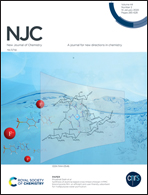Efficient blue, green and red iridium(iii) complexes with noncovalently-linked pyrazole/pyrazolide rings for organic light-emitting diodes†
Abstract
Noncovalently-linked rings are broadly employed to construct highly planar semiconductors exhibiting substantial electron and hole transport characteristics. In this paper, three cyclometalated iridium(III) complexes with blue, green and red emissions (B-Ir1-H, G-Ir2-H and R-Ir3-H) using 2-(2,4-difluorophenyl)pyridine, 2-(4-(trifluoromethyl)phenyl)pyridine and 4-(4-(trifluoromethyl)phenyl)quinazoline as main ligands, respectively, and dipyrazole as the ancillary ligand containing the nitrogen–hydrogen N–H–N bond were synthesized with an absolute phosphorescence quantum efficiency of 0.66, 0.55 and 0.38 in degassed CH2Cl2 solution, respectively. The iridium complex adopts a distorted octahedral coordination geometry, and the Ir–N–N⋯H–N–N heterocycle exhibits a planar conformation, with a slight twist between the N–Ir1–N plane and two adjacent N–N–H planes, and its dihedral angles are about −5.8 and 7.6°, respectively. Moreover, the organic light-emitting diodes (OLEDs) with the configuration of ITO/HATCN (hexaazatriphenylenehexacabonitrile, 5 nm)/TAPC (bis(4-(N,N-ditolylamino)phenyl)-cyclohexane, 30 nm)/Ir(III) complex (x wt%): 2,6-DCzPPy (2,6-bis-(3-(carbazol-9-yl)phenyl)pyridine, 10 nm)/TmPyPB (1,3,5-tri((3-pyridyl)-phen-3-yl)benzene, 40 nm)/LiF (1 nm)/Al (100 nm) (x wt% = 6, 8 and 2 wt%, respectively) show different performances. The green device displays the best performance showing a maximum luminance of 36 020 cd m−2, a maximum current efficiency of 53.8 cd A−1 and a maximum external quantum efficiency of 21.0%, respectively, with low efficiency roll-off. The EQE could still be kept at 20.7% even at the high brightness of 5000 cd m−2. These results indicate that the ancillary ligands with noncovalently-linked rings might provide a new pathway for constructing highly efficient phosphorescent emitters for OLEDs.



 Please wait while we load your content...
Please wait while we load your content...